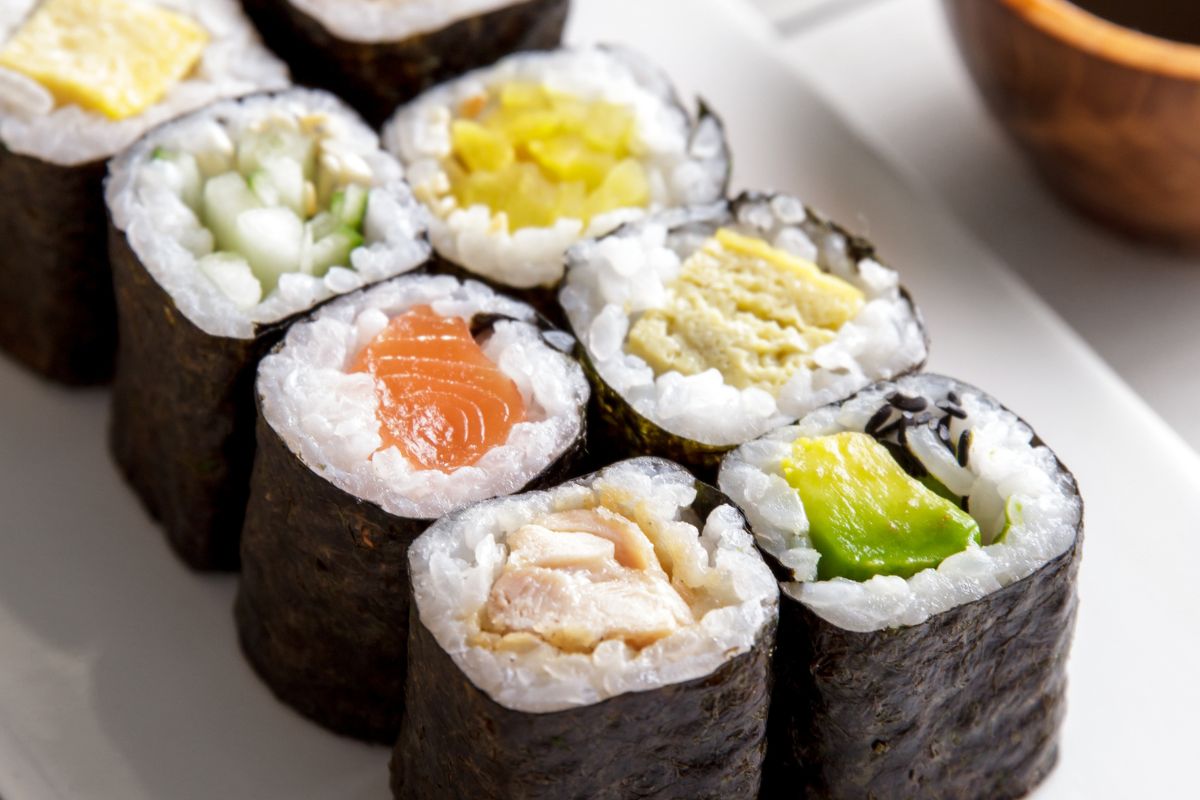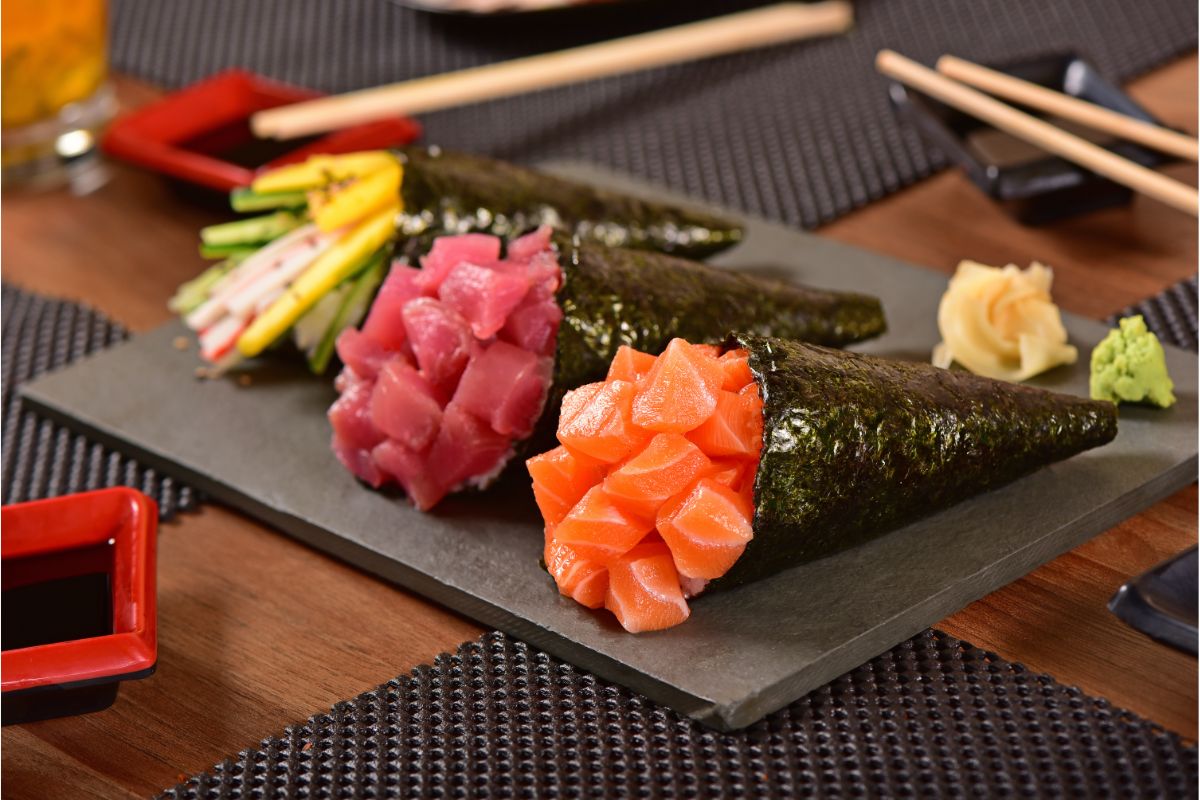Who doesn’t love a little sushi for lunch or dinner?
Arguably one of the most popular Japanese dishes in the last 40 to 50 years, these bite-sized portions have taken the culinary and restaurant world by storm, whether they’re from behind the encounter at a sushi restaurant, or made with your own two hands in your kitchen!

However, when you go to a Japanese restaurant or sushi bar, you may be confused as to why there are many different types of sushi on the menu.
Yes, you have the meat, fish, or vegetable types of sushi. But what exactly is ‘maki’, for instance? How is it different from ‘sashimi’, or ‘nigiri’? Are they all sushi, or none of them?
These are the kinds of questions that you can always ask a member of staff when you’re in a restaurant.
But if you feel more comfortable knowing beforehand (or just want to impress your fellow diners with your sushi trivia knowledge), this is the guide for you!
What Exactly Is Maki?
So, before we start looking at other kinds of sushi, we should probably first explain what maki is. It’s in the title of this guide, after all!
Maki almost always consists of a central ingredient, wrapped in a bed of sushi rice and a sheet of nori (seaweed). There are a few variations on this style of ‘sushi’ (which we will discuss in more detail later), but this is how it is most often presented.
This is arguably the most famous kind of sushi out there, and the way that it looks when people think of the word ‘sushi’.
‘Real’ Sushi
In Japan, however, you’ll find that ‘Sushi’ primarily refers to the rice used in this recipe, rather than the food that you’re presented at a restaurant.
The full name for that term is actually ‘Makizushi’, which refers to sushi rice and other ingredients that have been rolled. That’s pretty much the defining feature of this kind of sushi, that it has been rolled into its presented shape!
And, as you’ll probably have noticed, it’s the first part of ‘Makizushi’ that got broken off to define this kind of Japanese food.
Types Of ‘Maki’
As we briefly touched on before, there are more than a few ways to make and present maki as a meal. And, with the main distinguishing factor of maki being that it is rolled, there are quite a few versions that have popped up over the years!
‘Normal’ Maki
This is maki as we described it in the first section of this guide. You have your main ingredient in the center of the roll, sitting on a sheet of cooked sushi rice (usually cooled), that is wrapped in a sheet of nori.
It’s maki in its simple form, and it’s often many people’s preferred way of eating maki, thanks to this simplicity.
While many people might assume that you can only put some kind of fish or seafood into a maki roll, the truth is that you can pretty much put any kind of food in a maki roll, and it’s going to work.
So, for every classic crab (see also: What Is Kani?)meat or salmon maki roll you get, you’ll get beef, teriyaki chicken, cucumber, or avocado too, many of which people even prefer over seafood maki!
‘Inside Out’ Maki (Urumaki)
This is the first variant of maki that we’ve come across, and one that many people who enjoy maki will be familiar with, even if they don’t recognize it as maki.
Instead of the nori holding the rice and filling in the center, it is the rice that surrounds the nori and filling in this version.
It can be a little trickier than standard maki to get right, as you need to get the consistency and sticky texture of the rice right to hold everything else inside, but it is still not the most difficult.
Plus, the sticky rice on the outside allows you to add extra to your maki roll that might stick, from sesame seeds to seasonings like chili or paprika powder!
‘Cone’ Maki (Temaki)

This is probably the most substantial and largest type of maki that you’ll find out there.
Instead of rolling your ingredients evenly to create a near-perfect cylinder, the nori and rice roll around the main filling or fillings into a cone shape.
The ingredients will stick out of the top, while the bottom of the temaki roll will be sealed with nori to stop anything from falling out.
These are often quite big compared to standard maki rolls, as the finished roll is not sliced into smaller pieces. These are pretty much small meals, neatly wrapped up!
And of course, you can get pretty much any kind of filling in these too, from caviar to cream cheese!
(Although we haven’t been to an authentic Japanese restaurant that sells cream cheese maki. Still, we can dream!)
Different Kinds Of ‘Sushi’
You’ve almost certainly also heard the term ‘sushi’ being applied to other rice-based Japanese snacks.
Given that it’s the rice that makes a dish a ‘sushi’ dish, what exactly makes things like sashimi or ‘nigiri’ different from maki?
Nigiri
Instead of being rolled by rice and nori, nigiri is instead a thin slice of seafood or meat that is placed on top of a small ball of sushi rice.
Sometimes you may find that nigiri is served with a wrap of nori across its lengthways, but you can also find it with just a small amount of wasabi between the meat and the rice(see also: What Is Wasabi?).
Sashimi
Sashimi is the only type of Japanese dish that we’ve discussed that doesn’t count as ‘true’ sushi. Here, instead of being served with sushi rice, a slice of fresh raw fish, with no extra ingredients.
They’re a simple dish, but one that professional sashimi chefs take great lengths to get the best fish and cuts for, both for flavor, as well as for health reasons.
Final Notes
So, not only have we learned that ‘sushi doesn’t exactly mean what we think it means, but we’ve also learned a little about some other classic Japanese meals that, while similar, are also very distinct.
And, of course, we know everything we need to know about maki to ask for it at a restaurant!
- Dealing With Mold on Oyster Mushrooms - April 9, 2024
- What Meat Goes With Pumpkin Ravioli? (Ravishing Ravioli Combos) - March 15, 2024
- What To Dip Cheetos In? (Crunchy Cheese Puffs Concoctions) - March 4, 2024
